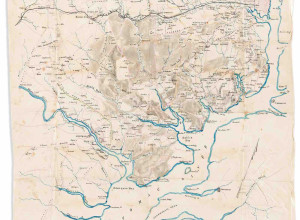“Shakespeare in Print and Performance” at the Ransom Center
 AUSTIN, Texas—On the 400th anniversary of William Shakespeare’s death in 1616, the Harry Ransom Center, a humanities research library and museum at The University of Texas at Austin, presents the exhibition “Shakespeare in Print and Performance,” commemorating the enduring legacy, longevity and relevance of the most frequently performed and most venerated English playwright. The exhibition draws on the Ransom Center’s notable and unique collections of internationally recognized performance materials, set designs and printed books, many of which have never been exhibited.
AUSTIN, Texas—On the 400th anniversary of William Shakespeare’s death in 1616, the Harry Ransom Center, a humanities research library and museum at The University of Texas at Austin, presents the exhibition “Shakespeare in Print and Performance,” commemorating the enduring legacy, longevity and relevance of the most frequently performed and most venerated English playwright. The exhibition draws on the Ransom Center’s notable and unique collections of internationally recognized performance materials, set designs and printed books, many of which have never been exhibited.The exhibition brings together a wealth of Shakespeare material, beginning with the earliest printed references to the playwright. Early examples include Robert Greene’s “Groats-worth of Wit” (1592), the first contemporary reference to Shakespeare in print, in which the up-and-coming writer is referred to as “an upstart Crow, beautified with our feathers.”
“It’s fascinating that he is being documented prior to being a published author,” says Gerald Cloud, Pforzheimer Curator of Early Books and Manuscripts. “We think we know so little about Shakespeare, when in fact there’s quite a lot that’s known just from these rare printed books. With this exhibition we bring visitors closer to Shakespeare.”
On view will be items from the Ransom Center’s Pforzheimer collection, including the earliest mention of Shakespeare’s name in print, source material that Shakespeare is known to have read, and rare books of which only a handful of copies are known. Also on display will be three copies of the first printing of Shakespeare’s collected plays — the 1623 first folio — and a copy of the third folio (1664), which attempted to add seven new plays to Shakespeare’s repertoire.
There is no official version of Shakespeare’s work; the author left behind neither diaries nor manuscripts. To gain insight into his legacy, scholars rely on studying variations in the printed versions of his plays. The exhibition’s textual and literary interpretations section takes visitors from the 17th century through the 20th century.
Shakespeare’s plays have been staged more often than those of any other English playwright. The performance section highlights particular ways in which producers, directors, artists, actors, designers and playwrights have created diverse and unique interpretations of Shakespeare’s plays.
“One of our goals in this exhibition is to highlight the incredibly different ways directors, designers, playwrights and actors have interpreted the Bard’s works in performance,” says Eric Colleary, Cline Curator of Theater and Performing Arts. “I am particularly excited that, for the first time, visitors can see John Wilkes Booth’s promptbook for his staging of ‘Richard III,’ and Rosalind Iden’s gown for Beatrice in Donald Wolfit’s touring production of ‘Much Ado About Nothing.’ ”
Visitors will explore different approaches to historical accuracy and authenticity in Victorian productions of Shakespeare, and then see how early 20th-century set designers abandoned those meticulously detailed sets and revolutionized Shakespeare for a modern audience.
“Edward Gordon Craig's English edition of ‘Hamlet,’ published in 1930 by Cranach Press, is a beautiful example of how a performance of Shakespeare actually informed a printing of the play,” says Chelsea Weathers, research associate for visual materials. Craig staged a famous production of “Hamlet” in Moscow in 1911-12; viewers will be able to see Craig's and Robert Edmond Jones’ set designs, loaned by the McNay Museum, alongside similar woodcuts in the book.
Shakespeare’s plays have an enduring quality, versatility and ability to affect the human spirit and imagination that is unmatched by any other author in the Western world. The Ransom Center’s unique exhibition will intrigue and educate both casual visitors and scholars.
“Shakespeare in Print and Performance” will be on view in the Ransom Center Galleries on Mondays through Fridays from 10 a.m. to 5 p.m., with extended Thursday hours until 7 p.m. On Saturdays and Sundays the galleries are open from noon to 5 p.m. The exhibition is free and open to the public. Daily public tours are offered at noon, Thursdays at 6 p.m., and Saturdays and Sundays at 2 p.m.
Image: James I, King of England, 1566-1625, "The Workes of the Most High and Mightie Prince, James by the Grace of God, King of Great Britaine, France and Ireland, Defender of the Faith, &c." (London, 1616). Portrait of King James I. Image courtesy of Harry Ransom Center.















